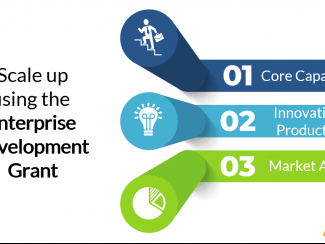Workplace Happiness Survey
The year 2020 saw drastic changes to work cultures, behaviours and arrangements globally as the Covid-19 pandemic resulted in retrenchment, pay cuts and new work from home structures, all factors that led to increased amounts of work stress and that may impact workplace happiness.
We recently did a survey from November 2020 to January 2021 with more than 850 respondents, to find out how happy they are at work. The survey was conducted online on workplacehappiness.sg, with responses from various industries including retail, service, tourism, healthcare and more.
For this study, the margin of sampling error is +/-3 percentage points at the 95% confidence level for results based on the entire population of employed adults.
Singapore's Workplace Happiness Results
Despite the setbacks, we found that the Singapore's overall workplace happiness score is 68 out of 100, a sharp increase from 59 in 2014. The Happiness Index was derived in consideration of the 4 key workplace happiness categories namely one’s basic work needs, sense of belonging, engagement, and well-being. As seen in Chart 1, 63% of the respondents are happy working with a happiness index between 70-100, while 14% of them were “unhappy” with a happiness index below 50.
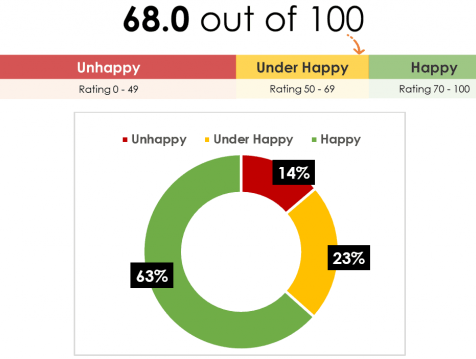
Chart 1: Singapore's Happiness Index
Despite the setbacks, we found that the Singapore's overall workplace happiness score is 68 out of 100, a sharp increase from 59 in 2014. The Happiness Index was derived in consideration of the 4 key workplace happiness categories namely one’s basic work needs, sense of belonging, engagement, and well-being. As seen in Chart 1, 63% of the respondents are happy working with a happiness index between 70-100, while 14% of them were “unhappy” with a happiness index below 50.
Other key insights from the survey include the fact that Baby Boomers are the happiest at work with an average happiness index of 72.8 out of 100 on the happy band. Interestingly, employees who do not work from home are the ones with the highest work-life balance.
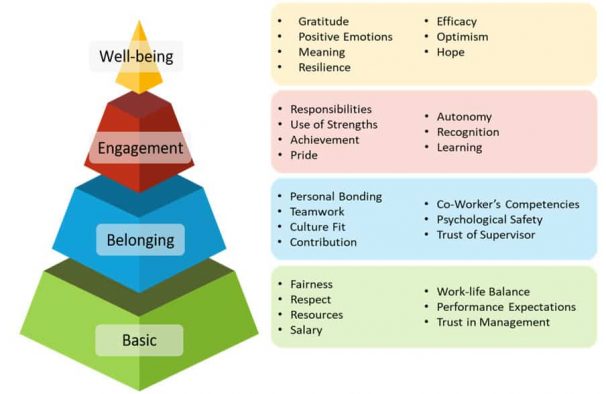
Diagram 1: Individual Hierarchy of Needs at Workplace
The survey was based on positive psychology and an adaptation of Maslow’s Hierarchy of Needs that divided 28 factors into 4 levels namely Basic Needs at Work (fairness, respect, resources, salary, work-life, balance, performance expectations, trust in management), Belonging (personal bonding, teamwork, culture fit, contribution, co-worker’s competency, psychological safety, trust of supervisor), Engagement (responsibilities, use of strengths, achievement, pride, autonomy, recognition, learning) and Well-Being (gratitude, positive emotions, meaning, resilience, efficacy, optimism, hope). It studies the workplace happiness factors important to happiness at work.
Unhappy Employees Have 4x Higher Desire to Resign
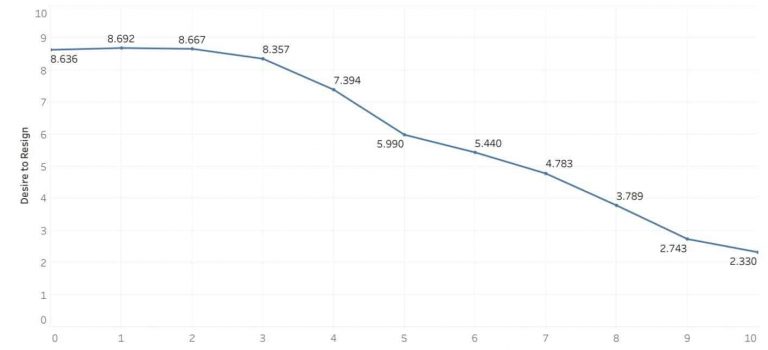
Chart 2: Correlation between Workplace Happiness Index and Desire to Resign
From the results, employees with high workplace happiness index have up to 4 times less desire to resign. It can also be noted that employees who maxed out their happiness scores tend to display a small desire to resign. The implications to a company would then be to work towards improving employee’s workplace happiness to reduce attrition rates, but keep in mind that some employees would leave nonetheless, and these may be your happiest employees.
Top 3 Factors that Impact Workplace Experience
The survey found the top 3 factors that have the most impact on workplace happiness to be Pride, Positive Emotions, and Gratitude.
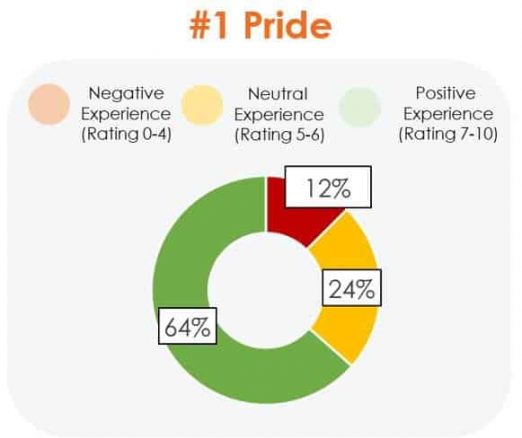
Pride (“I am proud working in my company.”) is ranked as having the highest impact on workplace happiness. Recognising this, examples of what employers can do to foster more pride at the workplace includes
- practising the company mission and values statements daily,
- sharing about the company’s history and key milestones, and
- encourage employees to initiate activities and project that they will be proud of.
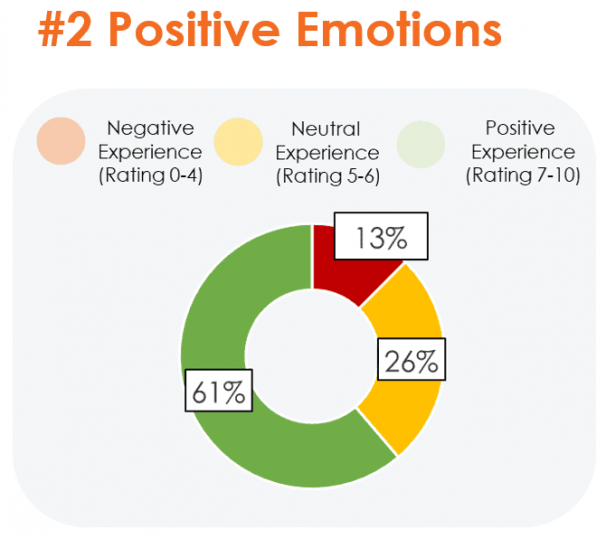
Positive Emotions (“I often feel positive at work.”) came in second on the impact it has on workplace happiness. Examples that companies can use to quickly generate positive emotions includes:
- Having their leaders be conscious of the words they use at work, be it in meetings, conversations and even emails.
- Encourage greater use of positively framed sentences that focuses on solutions that can be worked on, rather than blames and problems that cannot be resolved.
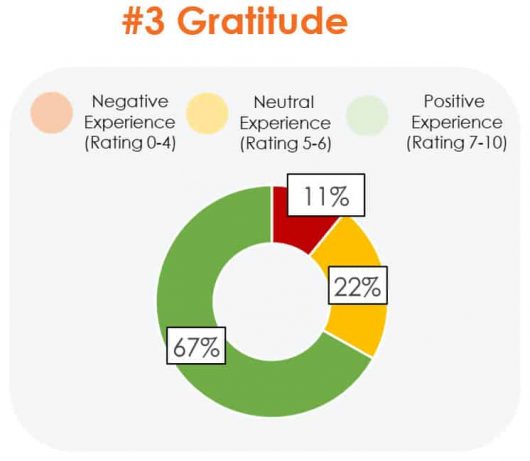
Gratitude (“I am grateful to my company.”) came in third on the impact it has on workplace happiness. We tend to feel gratitude when we notice that something good has come into our lives and we appreciate it. To foster more of it at the workplace, examples of what companies could do is to make that “something good” more apparent by having frequent gratitude sharing sessions where employees talk about the good things that occurred at work. Encouraging employees to openly appreciate one another’s work is also a good way to bolster gratitude.
Baby Boomers Are The Happiest
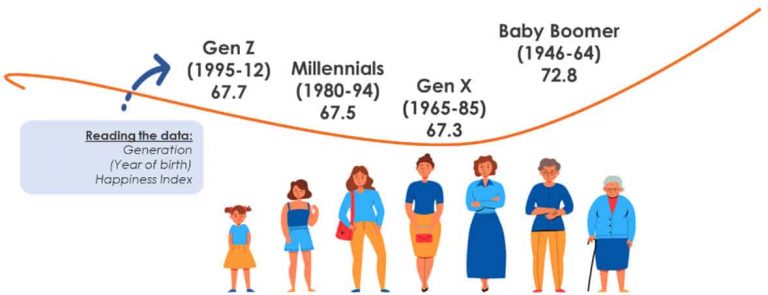
The survey also found that Baby Boomers (those born between 1946 and 1964) are the happiest with an average workplace happiness index of 72.8 on the happy band compared with Gen X (1965-85) at 67.3, Millennials (1980-94) at 67.5, and Gen Z (1995-2012) at 67.7. Baby Boomers also outscored the other generations in all 7 Well-Being factors.
Work-Life Balance Better When Work Is Done Fully In Office
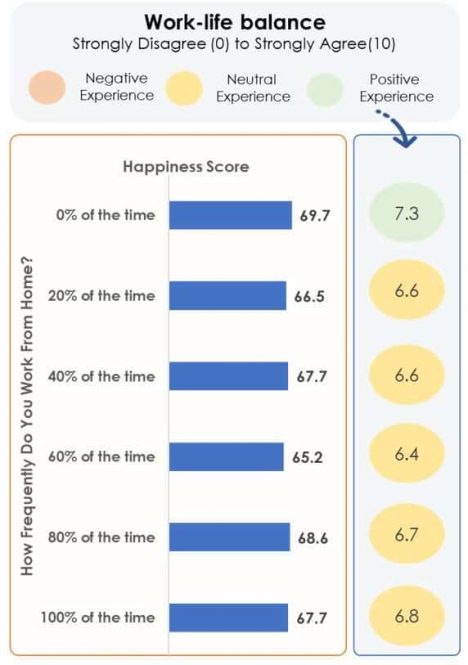
Chart 7: Correlation of Place of Work to Work-Life Balance
2020 is a year where many had explored working from home for the first time. In adapting to the new normal, the survey found that employees are almost equally happy working from home or in the office regardless of their work-life balance ratings. Chart 7 does show that those who work in the office believe that they have better work-life balance.
Despite the many changes 2020 brought, the survey found that most local employees are “happy” at work, with baby boomers being the happiest.
What Will It Take For Happiness To Increase?
"Singapore’s National Pledge have the word “Happiness” in it yet many of us chase after prosperity and progress, giving up happiness in exchange."
Low Boon Seong
There needs to be a concerted effort by many companies to recognise and put in the effort to increase Singapore’s happiness level.
When companies put people’s happiness aside because they have no time to work on people issues, they start to see spikes in resignations and decreased motivation to be productive, so actually hurts the business.
We are confident that bosses already know the importance of people. Without people, companies cannot function. So what can be done?
- Start by using the results from the national survey and see how Pride, Gratitude and Positive Emotions can be nurtured in your company.
- If you have more resources on hand, you may want to consider having a focus group discussion to hear from the employees the specific things that would boost their workplace happiness.
- If you lack time and resources, consider letting a HR Business Partner to manage this aspect for you. The cost can range from as little as S1250 if you leverage on government grants!
Other Recommended Articles


